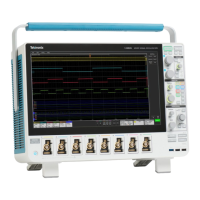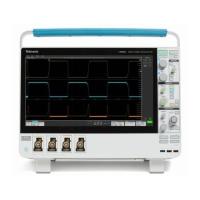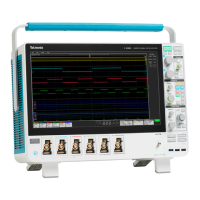Commands listed in alphabetical order
Returns
Required indic
ates the probe should be degaussed before taking measurements.
Recommended indicates the measurement accuracy might be improved by
degaussing th
e probe.
Passed indicates the probe is degaussed.
Failed indicates the degauss operation failed.
Inprocess indicates the probe degauss operation is currently in progress.
Examples
CH2:PROBE:DEGAUSS:STATE? might return :CH2:PROBE:DEGAUSS:S TATE
PASSED
, indicating that the probe attached to the Channel 2 is degaussed.
CH<x>:PRObe:FORCEDRange
This command sets the attached TekVPI probe to the specified range, or it queries
the range of the probe attached to the specified channel. The channel is specified
by x.
Group
Vertical
Syntax
CH<x>:PRObe:FORCEDRange <dynamicRangeN R3>
CH<x>:PRObe:FORCEDRange?
Arguments
<dynamicRangeNR3> specifies the probe range.
Examples
If a TCP0030 current probe is attached to the Channel 1 input,
CH1:PROBE:FORCEDRANGE 5.0 sets the attached probe to its 5 Ampere range.
CH1:PROBE:FORCEDRANGE? might return :CH1:PROBE:FORC EDRANGE
30.0000
, indicating that the range of the probe attached to the Channel 1 is
set to 30 Amperes.
CH<x>:PRObe:GAIN? (Query Only)
This query-only command returns the gain factor of the probe that is attached to
the specified channel. The channel is specified by x. The gain of a probe is the
output divided by the input transfer ratio. For example, a common 10x probe
has a gain of 0.1.
Group
Vertical
MSO54, MSO56, MSO58, MSO58LP Programmer 2-197
